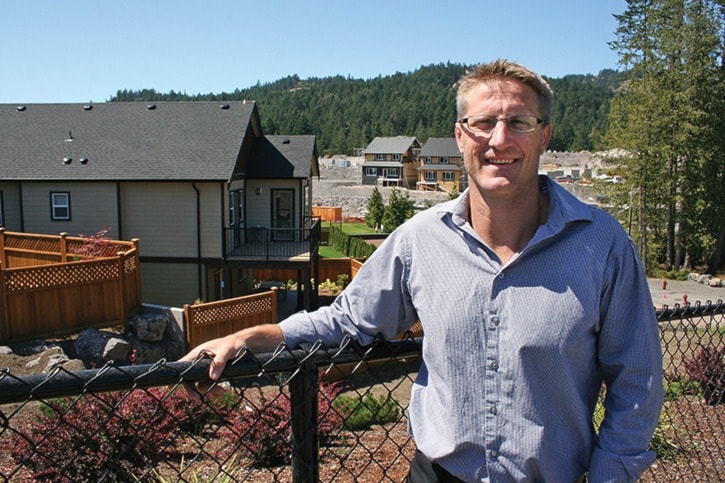One thing strikes a first-time visitor to the Westhills neighbourhoods perched on the hills between Langford and Glen lakes: this is no cookie-cutter development.
True, this massive, multi-phased project has been designed with density in mind, with houses built close together on mostly small lots. But look a little closer and one discovers that each home is not only distinctly different than the one next door, there are various configurations on each street.
One needs only walk a short distance to go from a traditional two-storey home, to a slightly larger model featuring a carriage home on the rear of the lot, to one with a built-in legal suite. And don’t forget the cluster townhomes, condo building and level-entry homes suited to residents with mobility issues.
“As much as there’s options, there’s also flexibility,” says Rohan Rupf, marketing director for Keycorp Marketing, the company promoting Westhills and a major player in the expansion of Langford as the Capital Region’s affordable new housing leader.
The 209-hectare property is billed as a “sustainable master-planned community,” one developed in partnership between owner Westhills Land Corp. and the City of Langford.
Its “green” characteristics currently include a geo exchange heating and cooling system that begins with a mass of pipes underneath Goudy Field at City Centre Park and feeds every home in the development – some use it for radiant floor heating. Its efficient use of the land will see roughly 40 per cent kept for green spaces and common areas.
So far, roughly 500 homes have been completed, including one condo building. Plans call for another 1,500 or so single-family homes on the property, Rupf says. Paradise Falls, a 160-lot area for which show homes are currently being built, is expected to have its first 30 or so homes ready this fall.
As the various phases of Westhills have been built starting in 2008-09, sales have been brisk, Rupf says, with some selling out in as little as one weekend. Buyers have included everyone from first-time home buyers or young families needing more space, to people looking for low-maintenance properties and retirees wanting to be close to amenities and family.
The development’s success to date boils down to some simple concepts, Rupf says. “If it’s not affordable, it’s not sustainable.”
Getting the people here based on affordability is one thing. Keeping them here is another.
Creating liveable homes with consistent quality construction helps. With many more phases yet to come, maintaining a good reputation is “huge,” Rupf says, noting it’s important that what people see in the show homes is what they get.
“More than 40 per cent of our sales are referrals from other residents. It’s reassuring to know your customers can talk about the area with confidence.”
It’s not all about price, either. The neighbourhoods are walking distance to City Centre Park, grocery stores, a multiplex theatre and numerous recreation options.
The new YMCA is expected to open by fall 2015 – as is the new Belmont secondary nearby – in an area known as The Core. The hub area will include a library, a lakefront pub and restaurant and a park and ride.
People are starting to understand that Westhills’ development is a part of the community’s growth, Rupf says. “It’s a benefit to the community the changes that are happening. It’s part of the overall plan.”
Find more information about the development at westhillsbc.com.
editor@goldstreamgazette.com
Q: WHAT IS TRADITIONAL NEIGHBOURHOOD DEVELOPMENT?
Traditional Neighborhood Development (TND), which was used in designing the master plan for the Westhills development in Langford, is a design technique that replicates historic development patterns found in North American towns and applies their basic elements to new development projects.
TND designs include compact, pedestrian-friendly development with a mix of land uses in a village-type setting, unlike the sprawling, conventional subdivisions that have dominated residential development since the mid-20th century.
The use of TND in place of a conventional subdivision reduces land consumption and preserves open space. TND can be used to develop entirely new communities, but can also be used to extend or fill in an existing community. Existing historic structures can also be incorporated into the TND.
– Landscapes2.org
GREATER VICTORIA MARKET UPDATE » AS OF JULY 14/14 COURTESY VICTORIA REAL ESTATE BOARD
» 266 / 583 -- NET UNCONDITIONAL SALES / TOTAL, JULY 2013
» 554 / 1,213 -- NEW LISTINGS / TOTAL, JULY 2013
» 4,634 / 4,772 -- ACTIVE RESIDENTIAL LISTINGS / TOTAL, JULY 2013
